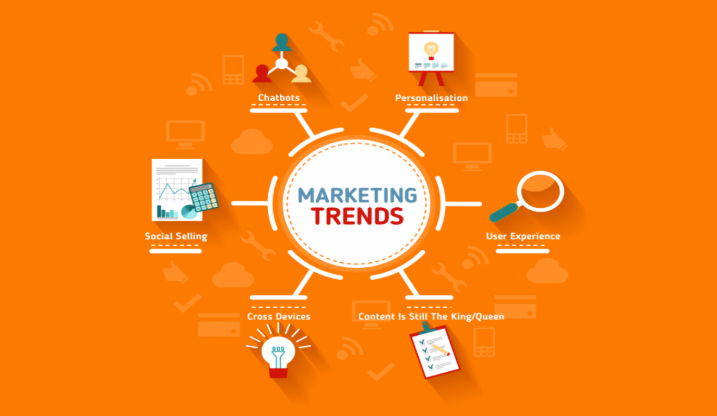The Current Trends in Media Marketing: What You Need to Know in 2025
Marketing has changed more in the past 10 years than it did in the 50 years before that. The way people consume content, interact with brands, and make buying decisions has been completely transformed by the internet, social media, and mobile devices. In 2025, media marketing is more fast-paced, data-driven, and personalized than ever before.
Saran
6/16/20255 min read


Marketing has changed more in the past 10 years than it did in the 50 years before that. The way people consume content, interact with brands, and make buying decisions has been completely transformed by the internet, social media, and mobile devices. In 2025, media marketing is more fast-paced, data-driven, and personalized than ever before.
In this blog, we will have a glimpse of the big trends in the media marketing era today. If you are a student, a marketer, or an entrepreneur, knowing these trends will make you ahead of the game.
Media marketing involves utilizing various forms of media—such as television, radio, newspapers, websites, applications, and social networking sites—to advertise products, services, or brands. In today's era, most media marketing occurs online, via platforms such as Instagram, YouTube, Google, and Facebook.
Media marketing involves:
Developing content (such as videos, blogs, advertisements)
Spreading it through paid promotion or influencers
Utilizing data and analysis to understand what works
Refining techniques to optimize outcomes
2. The Growth of Digital-First Marketing
Historically, most marketing budgets were allocated to TV, print, and radio. But no more. Today, digital media reigns supreme. In 2025, approximately 70% of all marketing budgets worldwide are being allocated to digital media. Why?
Individuals spend more time on the internet than they do in front of the TV.
Digital advertising costs less and is more trackable.
You can segment by age, interests, or geography.
Social media facilitates two-way dialogue between customer and brand.
Certain digital channels are extremely popular:
Search engines (Google, Bing)
Social media (Instagram, Facebook, X/Twitter, LinkedIn, TikTok)
Email marketing
YouTube and other video sites
Mobile apps and games
Social media is the core of media marketing now. Instagram, Facebook, and TikTok are the places individuals pass their hours every day. Brands follow the audience.
Social Media Marketing Key Trends:
a) Short Video Content:
Reels, YouTube Shorts, and TikTok videos dominate. Short, punchy videos that provide value in less than 60 seconds are what people adore. Brands now make investment in video storytelling so that they remain relevant.
b) Influencer Marketing:
Influencers have turned into mighty voices. They assist brands in reaching their target audience organically. Micro-influencers (10K–100K followers) are particularly popular because they possess a robust, devoted base.
c) Social Commerce:
They are able to shop from Instagram, Facebook, or TikTok directly within the app without ever having to leave. This blend of fun and shopping is known as social commerce, and it's taking off quickly.
d) Building Community:
Markets are more concerned with building loyal communities than just selling. They engage with their followers, respond to comments, share user-created content, and even launch brand challenges.
4. Content Marketing is Changing
Content remains king, but what kind of content works has evolved.
a) Personalized Content:
With the help of data and AI, brands are now able to produce content that addresses each user's interests personally. You may view a totally different advertisement or message than your friend does, even when you're both viewing the same site.
b) Value-Driven Content:
No one wants mere advertisements. Everyone desires to learn something, smile, or get inspired. That's the reason why blogs, how-to videos, memes, tutorials, and learn-tips are gaining more traction than ever before in form of traditional advertisements.
c) Interactive Content:
Polls, quizzes, live videos, AR filters, and even chatbots assist users in directly interacting with brands in real-time. This keeps individuals engaged and enhances their experience.
5. AI and Automation in Marketing
Artificial intelligence (AI) is contributing massively to media marketing these days.
a) Chatbots:
Numerous brands today employ chatbots on websites and messaging apps to respond to frequent questions, assist with purchases, and gather feedback.
b) Predictive Analytics:
AI solutions can forecast customer actions, enabling marketers to reach users at the optimal time with the optimal message. For instance, if a person frequently shops on Friday evenings, brands can schedule their offers at that time.
c) Content Creation:
Marketing assistants such as ChatGPT, Grammarly, and Canva enable marketers to produce quality content quicker. Although humans continue to manage the creative vision, AI assists them with research, ideas, grammar, and design.
Data is the most precious marketing asset in 2025. Marketers get information from every click, like, share, and scroll.
a) Real-Time Analytics:
Marketers currently use dashboards to monitor campaign performance in real time. If something is not working, they flip the strategy immediately.
b) A/B Testing:
Companies tend to test two versions of a campaign (A and B) to determine which one performs better. That is how Netflix determines what thumbnails to use, or how Amazon tests prices.
c) Privacy and Data Protection:
With more stringent privacy regulations (such as GDPR and India's DPDP Bill), businesses need to exercise caution in the way they collect and utilize data. Marketing with transparency and permission is now imperative.
Today's consumers switch devices and platforms rapidly. A single customer may spot a product on Instagram, look up reviews on YouTube, check the brand website on their desktop, and finally buy it from an app.
Omnichannel marketing provides a seamless and cohesive experience across all of these channels. For instance:
A user places an item in the cart on their smartphone.
They later get a reminder mail on the desktop.
They receive a push notification the following day.
The brand places a retargeting ad to jog their memory.
All of this is linked to push the user from consideration to purchase.
Increasingly, people are turning to voice assistants such as Alexa and Siri, or image search aids such as Google Lens.
Marketers are streamlining their content for:
Voice search terms ("Hey Google, where can I get running shoes?")
Visual search (submitting an image to find products of a similar look)
This requires brands to write more naturally, employ strong image tagging, and consider how humans talk or look instead of simply typing.
9. Sustainability and Social Responsibility
Today's consumers, particularly Gen Z and Millennials, are interested in what a brand cares about. They ask:
Is this company environmentally sustainable?
Does it give back to society?
How does it care for its people?
Brands today embed sustainability messages in their communications. Green marketing and cause-related campaigns are not only good morals—they are good for business.
Example: Companies such as Patagonia, The Body Shop, and IKEA openly discuss sustainability and gain trust by being transparent.
10. Near Future Trends to Watch
The following are some emerging trends that are gradually picking up steam:
a) Augmented Reality (AR):
AR enables people to "try before they buy." Customers, for instance, can try on glasses or lipstick virtually with their phone camera. This is particularly beneficial for fashion, makeup, and home décor brands.
b) Programmatic Advertising:
This is where advertising automatically gets purchased and displayed before the right people by means of AI. It's speedy, effective, and much, much more intelligent than by-hand buying of advertisements.
c) Marketing in the Metaverse:
Virtual worlds such as Roblox, Fortnite, or Meta's Horizon are being approached by brands to promote their goods, particularly among younger demographics.
What Should Marketers Do Now?
Media marketing in 2025 is all about adapting fast. With so many platforms and technologies, it’s important to stay updated. Here are some final tips:
Focus on short videos
Partner with micro-influencers
Create value-rich content
Use data smartly
Respect user privacy
Stay consistent across all channels
Show your brand’s human side
Remember, the most successful brands today are not the loudest—they are the most relevant, helpful, and authentic.
The Current Trends in Media Marketing: What You Need to Know in 2025
Connect:
Your one-stop solution for real estate websites.
+91 7736938330
© 2025. All rights reserved.
LV Complex, KHB Colony, 7th Block, Koramangala, Bengaluru, Karnataka 560095
